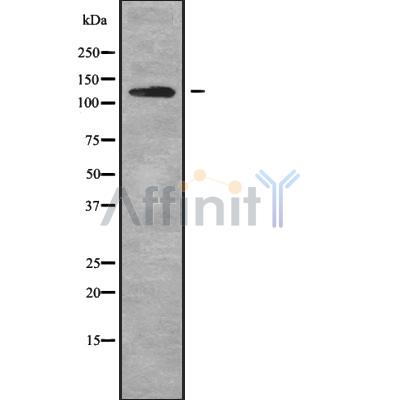AFF4 Antibody - #DF9180
| Product: | AFF4 Antibody |
| Catalog: | DF9180 |
| Description: | Rabbit polyclonal antibody to AFF4 |
| Application: | WB IHC |
| Reactivity: | Human, Mouse |
| Prediction: | Pig, Bovine, Horse, Sheep, Chicken |
| Mol.Wt.: | 127kDa; 127kD(Calculated). |
| Uniprot: | Q9UHB7 |
| RRID: | AB_2842376 |
Product Info
*The optimal dilutions should be determined by the end user. For optimal experimental results, antibody reuse is not recommended.
*Tips:
WB: For western blot detection of denatured protein samples. IHC: For immunohistochemical detection of paraffin sections (IHC-p) or frozen sections (IHC-f) of tissue samples. IF/ICC: For immunofluorescence detection of cell samples. ELISA(peptide): For ELISA detection of antigenic peptide.
Cite Format: Affinity Biosciences Cat# DF9180, RRID:AB_2842376.
Fold/Unfold
AF4/FMR2 family member 4; AF5Q31; Alf4; ALL1 fused gene from chromosome 5q31; HSPC092; Laf4; Lymphoid nuclear protein related to AF4 like; Major CDK9 elongation factor associated protein; MCEF; MGC107469; RP23-226J16.7;
Immunogens
A synthesized peptide derived from human AFF4, corresponding to a region within C-terminal amino acids.
Ubiquitously expressed. Strongly expressed in heart, placenta, skeletal muscle, pancreas and to a lower extent in brain.
- Q9UHB7 AFF4_HUMAN:
- Protein BLAST With
- NCBI/
- ExPASy/
- Uniprot
MNREDRNVLRMKERERRNQEIQQGEDAFPPSSPLFAEPYKVTSKEDKLSSRIQSMLGNYDEMKDFIGDRSIPKLVAIPKPTVPPSADEKSNPNFFEQRHGGSHQSSKWTPVGPAPSTSQSQKRSSGLQSGHSSQRTSAGSSSGTNSSGQRHDRESYNNSGSSSRKKGQHGSEHSKSRSSSPGKPQAVSSLNSSHSRSHGNDHHSKEHQRSKSPRDPDANWDSPSRVPFSSGQHSTQSFPPSLMSKSNSMLQKPTAYVRPMDGQESMEPKLSSEHYSSQSHGNSMTELKPSSKAHLTKLKIPSQPLDASASGDVSCVDEILKEMTHSWPPPLTAIHTPCKTEPSKFPFPTKESQQSNFGTGEQKRYNPSKTSNGHQSKSMLKDDLKLSSSEDSDGEQDCDKTMPRSTPGSNSEPSHHNSEGADNSRDDSSSHSGSESSSGSDSESESSSSDSEANEPSQSASPEPEPPPTNKWQLDNWLNKVNPHKVSPASSVDSNIPSSQGYKKEGREQGTGNSYTDTSGPKETSSATPGRDSKTIQKGSESGRGRQKSPAQSDSTTQRRTVGKKQPKKAEKAAAEEPRGGLKIESETPVDLASSMPSSRHKAATKGSRKPNIKKESKSSPRPTAEKKKYKSTSKSSQKSREIIETDTSSSDSDESESLPPSSQTPKYPESNRTPVKPSSVEEEDSFFRQRMFSPMEEKELLSPLSEPDDRYPLIVKIDLNLLTRIPGKPYKETEPPKGEKKNVPEKHTREAQKQASEKVSNKGKRKHKNEDDNRASESKKPKTEDKNSAGHKPSSNRESSKQSAAKEKDLLPSPAGPVPSKDPKTEHGSRKRTISQSSSLKSSSNSNKETSGSSKNSSSTSKQKKTEGKTSSSSKEVKEKAPSSSSNCPPSAPTLDSSKPRRTKLVFDDRNYSADHYLQEAKKLKHNADALSDRFEKAVYYLDAVVSFIECGNALEKNAQESKSPFPMYSETVDLIKYTMKLKNYLAPDATAADKRLTVLCLRCESLLYLRLFKLKKENALKYSKTLTEHLKNSYNNSQAPSPGLGSKAVGMPSPVSPKLSPGNSGNYSSGASSASASGSSVTIPQKIHQMAASYVQVTSNFLYATEIWDQAEQLSKEQKEFFAELDKVMGPLIFNASIMTDLVRYTRQGLHWLRQDAKLIS
Predictions
Score>80(red) has high confidence and is suggested to be used for WB detection. *The prediction model is mainly based on the alignment of immunogen sequences, the results are for reference only, not as the basis of quality assurance.
High(score>80) Medium(80>score>50) Low(score<50) No confidence
Research Backgrounds
Key component of the super elongation complex (SEC), a complex required to increase the catalytic rate of RNA polymerase II transcription by suppressing transient pausing by the polymerase at multiple sites along the DNA. In the SEC complex, AFF4 acts as a central scaffold that recruits other factors through direct interactions with ELL proteins (ELL, ELL2 or ELL3) and the P-TEFb complex. In case of infection by HIV-1 virus, the SEC complex is recruited by the viral Tat protein to stimulate viral gene expression.
Nucleus.
Note: Associates to transcriptionally active chromatin but not at snRNA genes.
Ubiquitously expressed. Strongly expressed in heart, placenta, skeletal muscle, pancreas and to a lower extent in brain.
Belongs to the AF4 family.
Restrictive clause
Affinity Biosciences tests all products strictly. Citations are provided as a resource for additional applications that have not been validated by Affinity Biosciences. Please choose the appropriate format for each application and consult Materials and Methods sections for additional details about the use of any product in these publications.
For Research Use Only.
Not for use in diagnostic or therapeutic procedures. Not for resale. Not for distribution without written consent. Affinity Biosciences will not be held responsible for patent infringement or other violations that may occur with the use of our products. Affinity Biosciences, Affinity Biosciences Logo and all other trademarks are the property of Affinity Biosciences LTD.

